This article was medically reviewed by Jake Behrens, MD. Dr. Behrens is the CEO and Director of Envision ADHD in Milwaukee. Dr. Behrens is an Assistant Clinical Professor at the University of Wisconsin and a practicing Psychiatrist. He completed his residency in Psychiatry at the University of Wisconsin Hospital and Clinics in 2013.
There are 11 references cited in this article, which can be found at the bottom of the page.
wikiHow marks an article as reader-approved once it receives enough positive feedback. In this case, 93% of readers who voted found the article helpful, earning it our reader-approved status.
This article has been viewed 296,239 times.
Research suggests a wellness plan can help you live a healthier, happier life.[1] A wellness plan is an action plan to support your physical, mental, spiritual, and emotional health. Experts say that wellness practices like eating healthy foods, incorporating stress relievers into your day, and practicing mindfulness may help you live a better life, so it's worthwhile to build a plan that works for you.[2] Fortunately, it's easy to customize your wellness plan to meet your needs and optimize your life.
Steps
Setting Up and Following a Wellness Plan
-
1Identify areas that could use improvement. Be honest with yourself about how satisfied you feel in each aspect of wellness. That way you can create a wellness plan tailored to your needs.
- Give each area a ranking from 1-10, with 1 being the poorest rank and 10 being the best.
- From this, you can determine which area needs the attention.
- But remember, each area relates to another, so you won't necessarily benefit from focusing all of your attention on one area to the detriment of others.
-
2Set goals. Once you identify the area or areas that you feel you need to work on, begin setting your goals.
- Write down specific goals you want to accomplish in each area. Create achievable short-term goals that will move you towards increasingly larger long-term goals.
- Make sure your long-term goals are also reasonable and doable. For example, if you are 25 years old, a reasonable long-term goal might be financial security by the time you retire at age 65. An unreasonable long-term goal would be becoming a billionaire by the age of 30.
- Be patient with yourself. Personal evolution does not generally take place overnight, nor is it usually very easy. But it is doable, so don't get discouraged if change doesn't happen immediately.
Advertisement -
3Keep track of your progress. Make up a chart or a journal in which you can outline each aspect of personal wellness and the goals for each.
- Set aside a calendar designated for tracking your wellness progress. Mark important dates and checkpoints so that you can see your progress. Begin by establishing your baseline of wellness for a particular aspect, write it down, then check in again after a month or two.
- Seeing the positive effects of what you have already accomplished may be the best motivational fuel.
Tip: Do regular personal assessments: are you feeling happier, more content? Do you have more energy, more fun- or laughter-filled moments? Are your relationships happier?
-
4Update your wellness plan. As you develop greater personal wellness, you may that certain goals take more or less time than you anticipated. Or you might find that some goals are no longer inside the scope of what you want to accomplish. So make a point to monitor your progress and reassess your needs every 6 months or so. That way you'll keep your wellness plan in harmony with your personal growth and progress.
- The process of achieving personal wellness is dynamic. Your needs, your goals, your environment, and your relationships may all change. You then want to decide how you want to change along with them.
- While your particular situation may change, by keeping these goals at the forefront, you can achieve a greater degree of control of how those changes will affect you. If for example, you set a weight loss goal of 10 pounds in 6 months, at the end of 6 months, re-evaluate that goal. Are you happy with your current weight? Do you want to lose more? If you are happy with your weight, your new goal may be maintenance. If you want to lose more, perhaps your new goal is 10 additional pounds in the next 6 months.
-
5Get support. Having the support of others can be crucial to maintaining your drive and motivation. Your supporters can hold you accountable, offer encouragement when needed, and perhaps even join you in your efforts.
- Get professional help and advice where needed. If for example, you want to improve your diet and nutrition to attain physical and mental wellness, you may want to consult with a nutritionist.
- If you are looking for financial stability, talk to a financial advisor.
- Join support groups that address whatever area(s) you might need encouragement in.
- Start a “buddy system” with a friend, spouse, or relative for various aspects of your wellness plan. For example, if you're working on financial wellness, getting your spouse involved can be an important step in getting closer to both relationship wellness and emotional wellness.
Assessing Your Wellness Levels
-
1Assess your current physical wellness. Physical wellness encompasses nutrition and physical fitness. Physical wellness also includes your medical wellness. Good medical wellness includes health-promoting medical practices like getting regular medical check-ups and using preventative healthcare. It also involves avoiding smoking, excessive alcohol consumption, and recreational drug use. Helpful questions to consider when assessing your physical wellness include:
- What are your physical goals? Are you interested in seeking out a personal trainer, or is there a coach you may want to consult?
- Are you looking for overall fitness, or are you looking to build your core, your cardiovascular health, your upper body strength, etc?
- Are you looking to build muscle tone, or are you more interested in increasing stamina and endurance?
-
2Assess your level of nutritional wellness. Nutritional wellness has to do with how well nourished and supported your body is.
- Consider your current diet and how well it serves your health. Note any areas for improvement.
-
3Assess your level of mental wellness. Mental wellness is a measure of how you cope with difficult situations and how well you balance your emotions.
- Consider your present mental wellness. Which emotions do you deal with most often? How well do you deal with those emotions? What changes or improvements would you like to see to your mental state?
-
4Assess your level of spiritual wellness. Spiritual wellness isn't about religion or personal faith but about how you perceive the meaning of life and your place in it.[3]
- Consider your current level of spiritual wellness: how fulfilled do you feel in your life? Do you lack a sense of purpose or efficacy?
Note: Spiritual wellness means that you are able to find meaning, hope, comfort, and inner peace in your life, whether through work, nature, art, music, family, or volunteer work.
-
5Assess your level of emotional and relationship wellness. Emotional and relationship wellness pertains to how well you are aware of, accepting of, and able to deal with your feelings and the feelings of those around you. Having healthy emotional and relationship wellness makes you feel more resilient and supported. Conversely, a lack of emotional wellness can sap your energy and happiness.
- Take account of your present relationships, stress level, self-esteem, and life outlook. Are there areas on which you'd like to improve?
- Are you happy? Do you feel weighed down by your relationships or emotions?
-
6Assess your level of intellectual wellness. This refers to the amount of information and knowledge you take in, and the amount of creative, critical and analytical thinking you put out. Learning, problem solving and mental productivity are important aspects of intellectual wellness.
- Consider your level of intellectual wellness. Are you intellectually stimulated by your life, or are you bored?
- Do you have sufficient creative outlets?
- How often do you use critical and analytical thinking?
-
7Assess your level of social wellness. Social wellness has to do with how you see your place in the world and in society and how well you adjust to your role in society.
- Consider your level of social wellness. Do you feel secure and confident in your social roles?
- Are you able to easily take up new and different social roles?
-
8Assess your level of occupational wellness. This aspect of personal wellness stresses the importance of having a positive attitude towards work, as well as having a rewarding and enriching career path.
- Consider your level of occupational wellness. Do you feel engaged by your work and career?
- Do you feel appreciated for your work?
- Do you feel enriched by the work you do?
- Are you satisfied with your career path?
-
9Assess your level of financial wellness. Financial wellness entails your sense of financial stability and health.
- Consider your level of financial wellness. Are you living within your means?
- Are you financially secure for the future?
- Do you have and keep a budget?
-
10Assess your level of environmental wellness. This aspect of wellness relates to your level of environmental consciousness. Your well-being is intertwined with the well-being of the environment around you.
- Consider your level of environmental wellness. Do you get enough fresh air, fresh water, and sunshine?
- Do you take time to appreciate the environment around you?
- Do you take measures to conserve energy and consume consciously?
Setting Wellness Goals
-
1Set goals for physical wellness. After assessing each dimension of your personal wellness, it's time to begin setting goals. Keep your initial goals simple and achievable. You don't want to get frustrated by difficult goals right off the bat.
- It's a good idea to go to a local fitness center and inquire about physical evaluations. Talk to your physician first before embarking on a physical wellness plan if you're overweight or have a history of medical problems.
- Start by walking more often. Park your car further away from an entrance and walk more. Use the stairs instead of the elevator or escalator. Walk around the block or take your dog out for a nice walk.
- Speak to your physician if you are overweight or have a significant medical history of heart disease, respiratory disease, arthritis, or any other serious medical condition. Your physician can help you set safe, reasonable goals.
- Make sure the physical activity you choose is something you like to do and not something someone talked you into. If you like the activity, you are much more likely to keep at it.
- Work your way up to increased activity. If you have spent the last 5 years with low to moderate physical activity, you're probably not quite ready for a triathlon. Start slowly and gently, increasing your activity level when you feel ready and able.
- Be patient and try a low-impact activity first like yoga, tai chi, or qigong.[4] [5] These ancient physical (and spiritual) exercises can improve health, reduce stress, reduce pain, and improve strength and balance.
-
2Set goals for your nutritional wellness. How do you know what the best diet is with all of the conflicting diets and advice? Try starting with some relatively simple rules:
- Consider speaking with a nutritionist who can help you determine the ideal nutrition for you and your body.
- Eat food that is as close to its natural form as possible. Try to limit processed and prepared foods and cook from scratch instead. Use a crock pot or stick to basic foods like rice, beans, and vegetables if you're pressed for time. You might also consider preparing food for the week ahead of time and storing it in the freezer until you're ready to eat it.
- Limit your red meat consumption (prefer grass-fed if possible). Increase the amount of fish (wild over farm raised) and skinless poultry you eat.[6]
- Increase the amount of fruits and vegetables you consume. Your intake of vegetables should be higher than your fruit intake, since fruit contains sugar. And carbohydrates would make you thirsty.
- Increase the amount of water you drink. Or at the signal of thirst you have to drink.
- Be alert for food sensitivities. If you suspect you're sensitive to a particular food, eliminate it from your diet for at least 2 weeks. Foods that may cause sensitivity include gluten, dairy, milk/lactose, tree nuts, shellfish, eggs, and soy.[7]
- Visit the American Academy of Nutrition and Dietetics (AND) website for advice on nutrition for kids, parents, men, women, and seniors.
- Give yourself 30 days on a new plan to form a habit and to fully evaluate the effects. Dedicating yourself to the plan for the full duration can be a powerful but difficult step so surrounding yourself with a knowledgeable and supportive community may be helpful.
-
3Set mental wellness goals. Mental wellness takes work, but even if you've suffered from depression, anxiety, or another mental disorder, you can improve your mental wellness with the right actions. Try these approaches to reduce depression, anxiety and stress:[8]
- Set aside time to quietly relax each day.
- Take a walk when you feel distressed.
- Set aside time to do relaxing activities you enjoy like reading, gardening, watching movies, etc.
- Learn and use deep breathing techniques. For example, breathe by expanding your abdomen rather than your chest. This technique allows your diaphragm--the flat muscle below you lungs--to drop by expanding your abdominal muscles. Take 100 deep breaths each day.[9]
- Practice positive affirmations. Some examples of positive affirmations include: “yes, I can,” “I am successful,” “I feel better every day,” etc. You might write your affirmation on a sticky note and post it where you can see it.[10]
- Seek out the support of a therapist or support group.
- Remember: If you're taking medication for a mental disorder, never stop the medication or change the dose on your own. Doing so can be very dangerous and you should only do so under the guidance of your mental health professional.
-
4Set goals for spiritual wellness. You can use many of the same techniques for mental wellness as for spiritual wellness. Some examples:
- Learn and use deep breathing techniques. For example, breathe by expanding your abdomen rather than your chest. This technique allows your diaphragm--the flat muscle below your lungs--to drop by expanding your abdominal muscles. Take 100 deep breaths each day.
- Meditate for a short period a few days a week. As you become more comfortable, gradually increase the amount of meditation you practice.[11]
- Remind yourself to stay calm and “in the moment.”
References
- ↑ https://www.nih.gov/health-information/emotional-wellness-toolkit
- ↑ https://www.hopkinsmedicine.org/health/conditions-and-diseases/coronavirus/coronavirus-practicing-wellness-while-you-stay-at-home
- ↑ http://familydoctor.org/familydoctor/en/prevention-wellness/emotional-wellbeing/mental-health/spirituality-and-health.html
- ↑ http://www.webmd.com/balance/guide/health-benefits-tai-chi-qigong
- ↑ http://www.webmd.com/balance/guide/the-health-benefits-of-yoga
- ↑ https://www.dietaryguidelines.gov/sites/default/files/2021-03/Dietary_Guidelines_for_Americans-2020-2025.pdf
- ↑ http://www.webmd.com/allergies/foods-allergy-intolerance
- ↑ http://spiritualityhealth.com/articles/building-blocks-calm
- ↑ http://www.drweil.com/drw/u/ART00521/three-breathing-exercises.html
About This Article
Before you begin drafting a wellness plan, try ranking each aspect of your wellness on a scale from 1 to 10, with 1 being the worst. Then, set both short- and long-term goals, which for your physical wellbeing could be something like walking 3 times a week or doing a triathlon. As your plan develops, update your goals to reflect what you've achieved. If you're struggling to stick to your plan, reach out to friends or family for support. To learn how you can work on your mental and spiritual wellness, such as by meditating, read on!
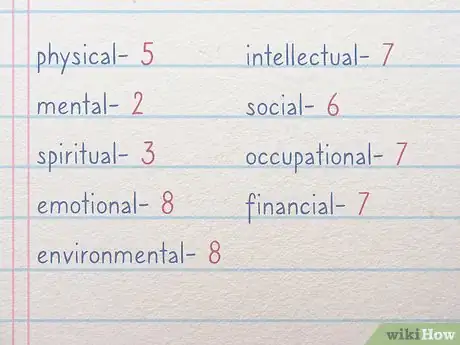


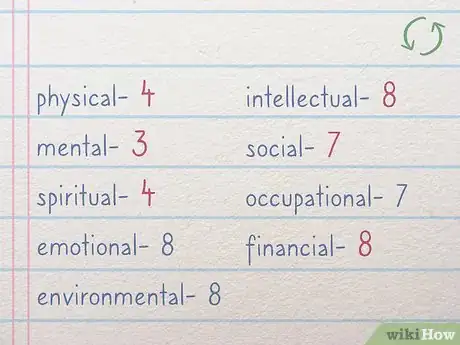



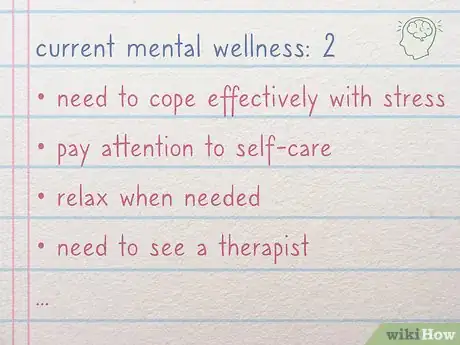
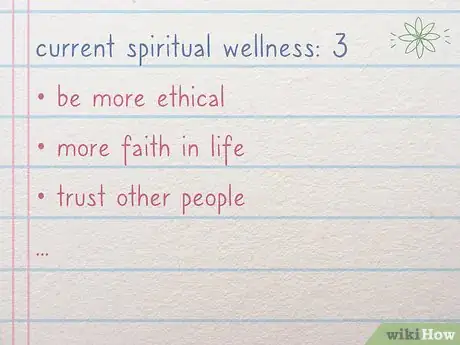
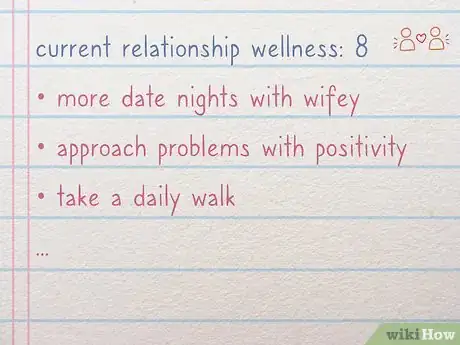
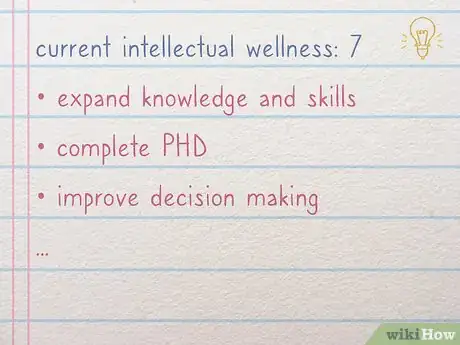
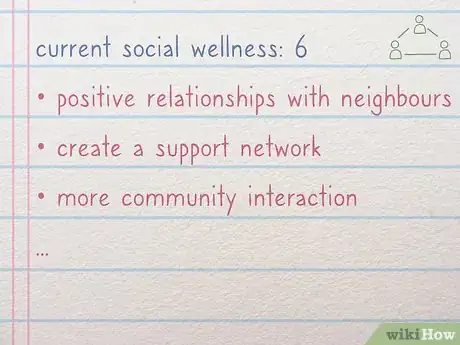
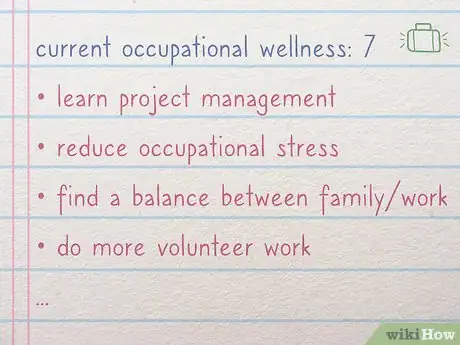

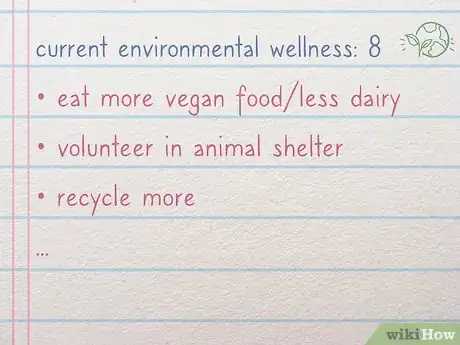
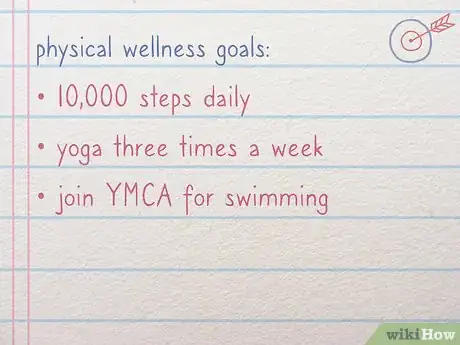

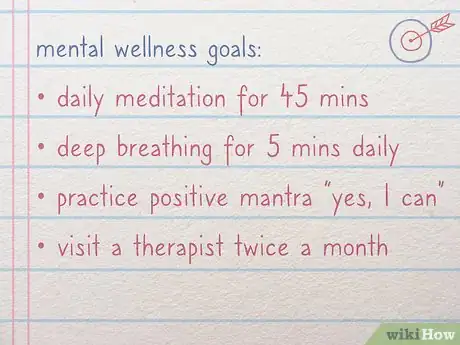











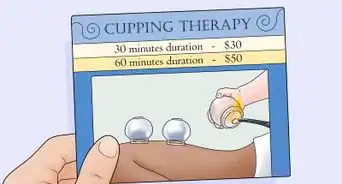




















































Medical Disclaimer
The content of this article is not intended to be a substitute for professional medical advice, examination, diagnosis, or treatment. You should always contact your doctor or other qualified healthcare professional before starting, changing, or stopping any kind of health treatment.
Read More...